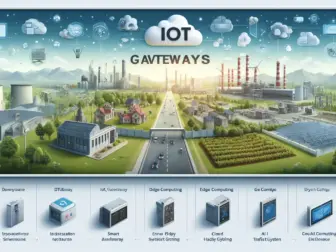Tag - CoAP
Blog , June 6, 2024 , AI Gateway, AI in IoT, Cloud Computing, Cloud-Edge Collaborative Gateway, CoAP, Data Acquisition Gateway, Data Transmission, Edge Computing, Edge Computing Gateway, Industrial IoT, IoT Applications, IoT Gateway, IoT Gateway Selection, Real-time Data Processing, Smart Gateway, Smart Traffic
The Power of CoAP in IoT Communication CoAP (Constrained Application Protocol) is a specialized web transfer protocol designed for use with constrained devices and low-power networks in the Internet of Things (IoT) ecosystem. CoAP provides a lightweight and efficient way for devices to communicate over UDP, making it ideal for applications that require low data usage, such as smart home devices, industrial sensors, and wearable technology. One of the key features of CoAP is its ability to work with constrained devices that have limited resources, such as memory and processing power. CoAP uses a simple request/response model similar to HTTP, but with optimizations to reduce overhead and improve efficiency for these devices. This makes it a popular choice for IoT applications where devices may have limited battery life or need to conserve resources. CoAP is also designed to be easily integrated with existing web technologies, allowing devices to interact with web servers and services using familiar RESTful principles. This makes it easy for developers to build IoT applications that leverage the power of the web, while also taking advantage of CoAP's lightweight and efficient communication protocol. Another key advantage of CoAP is its support for multicast communication, which allows devices to efficiently broadcast messages to multiple recipients on the network. This can be useful for scenarios where multiple devices need to be updated simultaneously, such as in smart lighting systems or environmental monitoring networks. Security is a critical consideration in IoT communication, and CoAP provides several mechanisms to ensure secure communication between devices. CoAP supports Datagram Transport Layer Security (DTLS) for encrypted communication over UDP, as well as authentication and access control mechanisms to protect against unauthorized access. Overall, CoAP is a powerful protocol for enabling efficient and secure communication in IoT applications. Its lightweight design, support for constrained devices, and integration with web technologies make it an ideal choice for a wide range of IoT use cases. By leveraging the power of CoAP, developers can build scalable and reliable IoT solutions that meet the demands of today's connected world.
The Power of CoAP in IoT Communication
CoAP (Constrained Application Protocol) is a specialized web transfer protocol designed for use with constrained devices and low-power networks in the Internet of Things (IoT) ecosystem. CoAP provides a lightweight and efficient way for devices to communicate over UDP, making it ideal for applications that require low data usage, such as smart home devices, industrial sensors, and wearable technology.
One of the key features of CoAP is its ability to work with constrained devices that have limited resources, such as memory and processing power. CoAP uses a simple request/response model similar to HTTP, but with optimizations to reduce overhead and improve efficiency for these devices. This makes it a popular choice for IoT applications where devices may have limited battery life or need to conserve resources.
CoAP is also designed to be easily integrated with existing web technologies, allowing devices to interact with web servers and services using familiar RESTful principles. This makes it easy for developers to build IoT applications that leverage the power of the web, while also taking advantage of CoAP’s lightweight and efficient communication protocol.
Another key advantage of CoAP is its support for multicast communication, which allows devices to efficiently broadcast messages to multiple recipients on the network. This can be useful for scenarios where multiple devices need to be updated simultaneously, such as in smart lighting systems or environmental monitoring networks.
Security is a critical consideration in IoT communication, and CoAP provides several mechanisms to ensure secure communication between devices. CoAP supports Datagram Transport Layer Security (DTLS) for encrypted communication over UDP, as well as authentication and access control mechanisms to protect against unauthorized access.
Overall, CoAP is a powerful protocol for enabling efficient and secure communication in IoT applications. Its lightweight design, support for constrained devices, and integration with web technologies make it an ideal choice for a wide range of IoT use cases. By leveraging the power of CoAP, developers can build scalable and reliable IoT solutions that meet the demands of today’s connected world.

